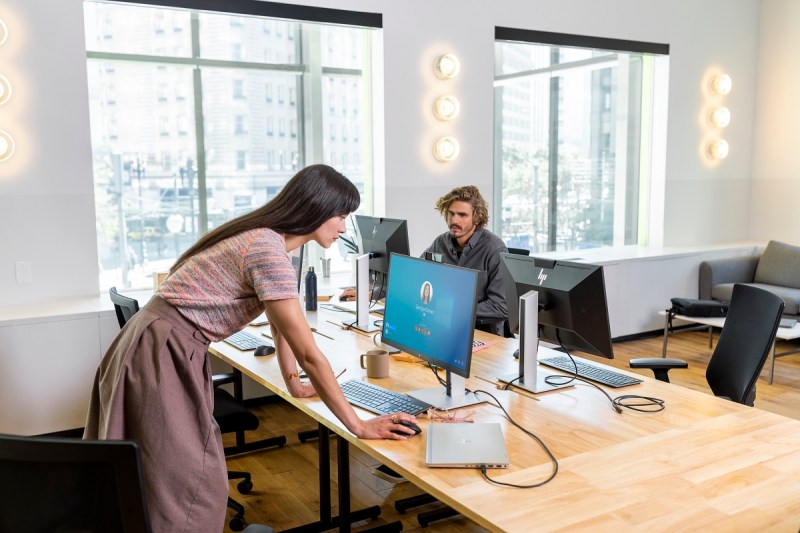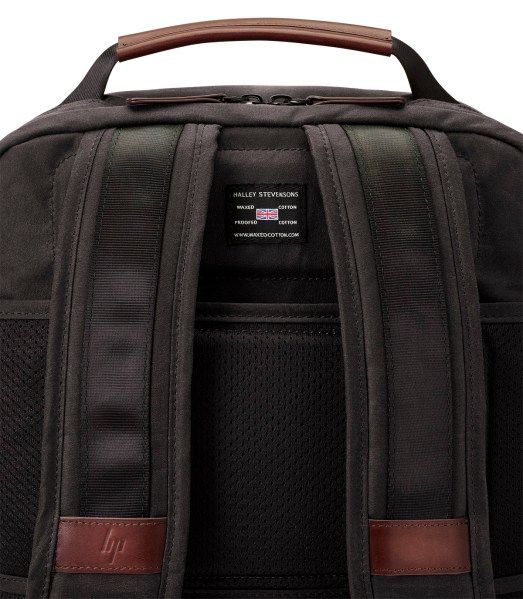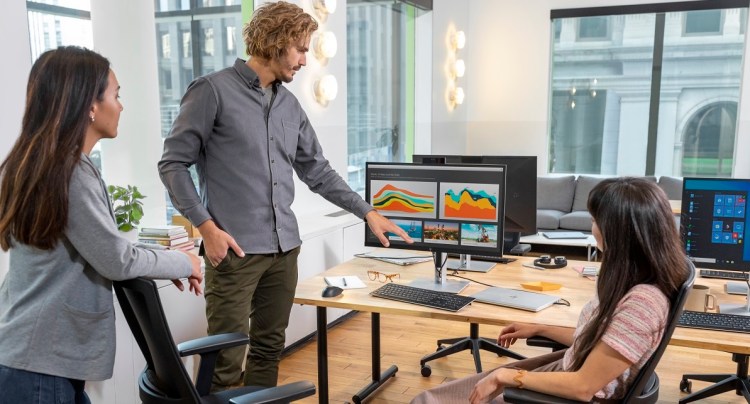Since Alex Cho took over as president of HP Personal Systems about 18 months ago, HP has been sparring with Lenovo for the title of the world’s No. 1 PC maker. At the moment, the latest numbers at the end of the third quarter of 2019 showed that Lenovo had 24.7% of the PC market, while HP had 22.4% with 14.6 million PCs sold.
But Cho said in an interview with VentureBeat that HP is focused on profitable growth. And he is also focused on how the market is changing and users are making different kinds of demands on their computers. Content creators are growing fast, and they’re the kind of people who invest in heavy-duty PC systems.
These users aren’t going to do their work on a smartphone, and that goes for a lot of people who are part of the smartphone generation, Cho said. That’s good for the PC.
I talked with him about HP’s lineup of new products at CES 2020, the big tech trade show in Las Vegas this week, as well as his thoughts on the future of computing. We also talked about the resurgence of Advanced Micro Devices in the past year, with its Ryzen-based processors that are taking the speed crown away from market leader Intel, which has had a hard time keeping up with demand.
June 5th: The AI Audit in NYC
Join us next week in NYC to engage with top executive leaders, delving into strategies for auditing AI models to ensure fairness, optimal performance, and ethical compliance across diverse organizations. Secure your attendance for this exclusive invite-only event.
Here’s an edited transcript of our interview.

Above: Alex Cho is president of HP Personal Systems.
VentureBeat: What is new among PC buying habits?
Alex Cho: I wanted to give you a summary of how we see things going forward, which is the context within which you’re starting to see our latest announcements. We’re very energized by what we’re seeing as we look forward. The PC is becoming increasingly relevant, particularly for the next generation of customers.
In the last few years we’ve spent a lot of time studying millennials. We’re studying all segments, but we’re also looking at the next generation, including Gen Z. Their usage on PC, time spent on PC, is growing above millennials. That’s always a good grounding trend. On top of that, what’s relevant from the compute side — this next generation is using the PC for higher engagement, higher-value activities.
We’ve been tracking three main areas. One is around creation, people using their PCs for anything from video to photography, any creative applications, both professionally and also for the non-professional. We’re looking at data around video blogging growing at a significant rate. In China the number of video bloggers already outnumbers the total population of the U.S. There’s a lot happening on the PC around all things creative.
Second is what we call consumption. That might be the world of watching Netflix or Amazon on your PC or compute device, as well as gaming. We talked about gaming last year. Gaming continues to be an ever-expanding PC-based usage activity. Then the third is continuing to grow in collaboration. People are very familiar with using Facetime and doing more on these PC-based devices.
For us, that overall — more eyeballs on PCs, higher engagement area — it just leaves us with a very energized view as we look forward around this entire category. How innovation can really help accelerate and build more value for customers, as well as what it means for us going forward in terms of growth.
VentureBeat: Not so long ago, everyone seemed to be predicting that the smartphone generation would only do things on mobile and wouldn’t use PCs so much. It seems like there’s a bit of a surprise result there. It makes sense that something like streaming video would be one reason. Are you surprised yourselves that the data shows the PC holding up?
Cho: I don’t know about surprised. If you surround yourself — if you look at the progression of the dialogue around the PC, a few years ago people were asking if the PC was dead. We clearly didn’t think so, as the performance of the industry in the past few years has shown. We do a lot of work around insights, following customers, and seeing that there are very unique experiences that people want more of, and that we can innovate for.
It’s less of a surprise, then, but it’s great reinforcement. It helps to substantiate where we’ve been making investments, knowing earlier some of these signs and areas where we believe that computing will add more value. Going forward, we see that compute architectures continue to evolve. It’s going to open up new areas for solutions that will be, in my mind, really breakthroughs.
If you look at our strategy, we divide it into three buckets. One is, we’ll continue to reinvent PC experiences around all of these areas people are spending more time on. Second, it’s around designing for the total experience. If you think about the contributions and the more immersive experiences that we can enable, you start with accessories and displays and broader ambient computing types of opportunities. The ability to deliver a total experience is very attractive. Third, it’s about getting into and continuing to grow services and solutions where all of these new compute models and a lot of data and AI is allowing us to deliver more value to our customers. We’re very bullish on what all of that means for the industry.
To be honest, it’s great to see the response, even in the short term, to the innovations we’ve been publicly releasing, and what we have planned for the next year. We’re super fired up as we go forward.

Above: The HP E24d G4 FHD Advanced Docking Monitor.
VentureBeat: I was curious about where you’ve landed this year on the No. 1 or No. 2 rank for 2019. I know Gartner and IDC always have their own opinions here. But what do you find this year?
Cho: We stay very focused on playing our game. I say that because we might go between number one or number two. But our strategy is around, at least from the HP side, driving profitable growth. We’re looking at, as I mentioned, reinventing PC experiences and delivering more immersive experiences, getting into services and solutions. It’s far less purely unit share dependent.
FY19 is a great example. In a period of very challenging CPU constraints, all of the mid-shift has been very favorable to us in terms of delivering operating profit growth. That’s right on strategy for us. There’s not a unit share goal. But that being the case, we still have a lot of scale, and we continue to stay in leadership.
VentureBeat: How would you characterize the parts of the market that are doing well or growing, whether it’s territories or types of machines?
Cho: That’s exactly where we’re focused. I’ll highlight a few, breaking them up into areas I mentioned where there’s increasing engagement.
Let’s just look at the whole create space. I mentioned the growth of creation on PCs, whether it’s professional people, professional creatives, or other people creating on their PCs. We’re very excited about this. Being able to create, providing a platform that facilitates people expressing themselves in creative ways, it’s such an energizing area of innovation. We’re very focused on that. Sixty-one percent of Gen Zs use their PC to create in some form. You see it in the professional segment, but also in a broad base.
When you look at the types of device solutions out there, you have several of our workstations. You look at our NV line. You look at what we’re doing around our Spectre products, particularly the larger 15″ area we announced. If you look at our devices that are more peak for enabling people to create, whether it’s video or 2D or 3D, those are growing in double digits off a small base. They’re still less than 10% of our mix, and growing double digits. That’s one example.
The second example I mentioned is consume, whether it’s media content or gaming. The x360 form factor is one that continues to be among the most attractive for those who are heavily into media consumption, as well as our gaming products. Both of those segments are growing in double digits. Third, I mentioned collaboration. Collaboration is one that happens in not just official meeting rooms, but in public places, huddle rooms, and so on. Our devices have peak conferencing solutions, as well as Sure View. Our data shows that people who are collaborating in public places a lot, they resonate very much with our Sure View integrated privacy panel. Our Sure View enabled units are growing double digits as well.
Those are some of the areas that are tied to larger trends, where we have some unique differentiation and innovation. We’re continuing to grow quite well. We have actually very balanced growth across all regions around the world.
This is all built around the theme of computing continuing to be more relevant. As that happens, one of the big visions we have is we believe that compute should adapt to people’s needs. No longer do people need to adapt to compute. We believe in adapting computing and how we innovate for people, to give them more freedom in how they compute. That’s a key direction for us.
We’ll be announcing, as you know, a 5G convertible, taking our Dragonfly and giving them all the flexibility of that worldwide convertible, less than 1 kilogram connected, as well as continuing to innovate in our areas of sustainability and enabling these devices to be not only secure, but well-connected and with 90% recycled materials. We also announced a lot of horsepower in the areas of creating content and consuming. Our 15″ Spectre is the most powerful Spectre convertible out there, with the longest battery life. We’re also announcing the world’s first and widest 4K all-in-one with RTX, so that people can really create on these devices in whatever environment. We’re announcing the ability to work from wherever and to quickly connect on our devices through the world’s first docking displays.
Across all of this is the theme of continuing to enable sustainability with our whole series of recycled laptops. As I mentioned, we’re taking the world’s first laptop with ocean-bound plastics and adding even more to that through recycled materials on a broader basis with that product.
VentureBeat: I was going to borrow a laptop, and one of my missions is to see if it can last through press day at CES. It made me think. For me, because that’s a peak day of the whole year, I need to get a laptop with enough battery life to get all the way through. Is that an example of the way people are buying their machines? They have a peak usage in mind and they have to gear everything they prioritize in the machine toward that peak usage.
Cho: We find that there are a lot of different types of episodes that people have throughout the day. We see different — not only personas, but these episodes where people are, say for work, transitioning from heavy content creation to consumption. Creation might be something as simple as email response, or creating analyses and presentations and proposals. Consumption might be getting through a lot of email or doing training online. More than 50% of collaboration, in most cases, is employees connecting with colleagues or customers on other sites. We see them transitioning through those things on the device.
That’s what we use as use cases for things like our Dragonfly products, our commercial notebook. We recognize they have a high need for performance, number one. It’s a full commercial device. Mobility, they’re moving around to different places. It’s the world’s first with — we have 4X4 LTE antennas, as well as Wi-Fi 6 that they introduced, making sure they’re connected and rapidly transferring data wherever they are.

Above: The HP Elite Dragonfly G2 is the world’s lightest compact business convertible laptop, HP says.
VentureBeat: I have to do a lot of video transfer on those days. It feels like that’s another big demand.
Cho: Right. People used to think that video was only for creative professionals, but we’re seeing use cases — people in all forms of work are accessing video-related content. Also, it’s all around collaboration, as I mentioned. We look at those use cases and design. That’s why we’re very excited about our Elite products, our Elite Dragonfly. It really pushes productivity, mobility, and security through the types of things people are doing throughout the day.
VentureBeat: I like the big displays. I thought the one feature that might make a difference if people were thinking of using the all-in-one or the big display for gaming is they’d want it at 120Hz instead of the 60Hz. Have you thought about this notion that you could have that product for all markets, for the gamers as well as the professionals and creators, if you changed that one feature? I don’t know if there’s more that gamers would demand on top of that, but I generally see the folks who are touting displays for gamers delivering them at 120Hz or 240Hz. Putting one out there at 60Hz seems like it might miss that part of the market.
Cho: We’re very much covering all the different use cases around displays, including 240Hz refresh rates. You’re absolutely right. If you look at our higher-end displays, we span that, but we also span down to where people are prioritizing other elements of the price-value stack. That’s why we have a continuum of refresh.
Obviously we have a continuum of sizes as well. For those who are looking for effectively two 24″ displays side by side, we announced our 43″ curved display. That includes our device bridge. Not only can you, from one PC, tile two windows side by side to maximize productivity, but you can also plug in two different devices simultaneously with a single keyboard and mouse and manage across both. That gives you another type of use case enablement.
Especially for these work environments — touchdown stations are such a big part of the experience. They may not be sitting down all the time, but when they sit down they want to be immediately and quickly productive. These docking displays that are fully manageable, so IT feel like they can manage it — it’s a corporate resource — that’s also part of what we’re offering.
As you know, we have it tuned for office environments, for gaming environments, and for workstation environments, our Z display, where we’re prioritizing DreamColor and higher use cases that are very tied to creative workloads. We’re very much enabling that across the portfolio.
VentureBeat: There isn’t a specific line of gaming products being announced at CES, but does gaming remain a big priority for you?
Cho: Oh, yes. We love gaming. You know we love gaming. It continues to grow. What’s interesting, gaming is something — there are more and more segments participating. Not only is the core gaming segment growing, but as well, women are now 40% of the market. Seventy percent of the market is over 18. You have multiple segmentations around people who are enthusiasts or casual.
Our plan is to continue to innovate. It’s not just a hardware play, too. It’s around building the ecosystem experience. We have fantastic innovation around our core products. We announced the world’s first dual-screen gaming laptop, for example. Then really curated displays and accessories around this, whether it’s a zero-latency wireless mouse or displays operating at 240Hz. Very much adding to or completing the immersiveness of experience, and branded together for the overall portfolio.
Third is the services and software around it. We took Omen Command Center, our online platform by which you can configure your accessories and products, and earlier we introduced AI coaching for League of Legends. We also announced a rewards program here in the U.S. Across the products, accessories, displays, services, AI, it’s very holistic. It’s an attractive segment, because there’s so much innovation and so much interest. It’s a wide demographic. People’s experience with us is such an important part of the overall compute portfolio we offer.
We don’t have new gaming product announcements at CES because we have a lot that we’re planning this year. We’re trying to space it out, especially tied to some gaming-focused venues later in the year. But we have a lot coming. It’s cool. It’s super cool and exciting.
VentureBeat: Last year at this time we probably both thought we’d hear more about 5G in 2019. Now it feels like we’ll wait a bit more into the next year for 5G use cases to come to life.
Cho: I feel as though — if you look at this year, at least from our side, we did a lot around enabling better connectivity. Let’s talk about 4X4. It’s very important, so that LTE gets materially faster. That’s available today, and that’s something that the end user will experience all the way through, because infrastructure is available to them all the way through from the device to the provider. Even Wi-Fi 6, that’s very material. This isn’t stuff that doesn’t get materialized end to end. The end customer experiences the benefits of that. We introduced that, and we’re the world’s first across consumer and commercial device innovations for this year.
In the whole area of connectivity, we’re very bullish on staying at the meaningful leading edge on this. You see it across our portfolio. We did a lot, and it’s been a very important part of our Net Promoter Score. Net Promoter Score is a religion for us, and connectivity that users see in what they experience and what they do is important.
We’re announcing, at CES, on our commercial platform, 5G enablement. As the market gets more mature and ready, really enabling it, we’ll do that across the broader portfolio. Connectivity is something that we have a lot of passion on. We think it improves the experience. Because of that, you see a lot of energy around it. We did it in many practical, tangible, and leading ways in FY2019.

Above: HP Spectre Folio Backpack
VentureBeat: On the experimental side, how are you looking at some of those products? I think of things like the Sprout style of computers, taking advantage of 3D capture or 3D printing.
Cho: We announced, at Adobe Max, our broader vision around what we call capture, create, and experience. By that we mean we’re formalizing this ecosystem — tied to my earlier point around growing creative use cases on the PC, we believe there are some rich growth opportunities.
When I say capture, create, and experience, on capture — this is all around taking the physical world and digitizing it. We announced a project together with Adobe that we call Project Captis. We’re able to capture 3D textures and help build libraries for the digital space. In the create space we have a rich portfolio of Z workstations tuned for creative workflows, whether it’s 2D and 3D, and helping to enable better creation. If you think of the offramps, what we call experience, whether it’s around 2D print, 3D print, displays, commercial VR, we’re continuing to offer the widest set of offramps on that.
We announced, first, that we’re formalizing continuing to take that end-to-end ecosystem from capture to create to experience even further. We’re partnering on key elements of it with partners, Adobe being a key one we announced. We’re continuing to take that to the next level. We announced Project Captis around the capture area. We’ve refreshed and we’re continuing to build around our create solutions in computing. We have a lot around the offramp touch points. You’ll see a lot more around that as we go forward.
VentureBeat: AMD had a historic year for its Ryzen processors. I wondered how that looks to you as far as how competitive the microprocessor battle is these days.
Cho: It’s been difficult, because we’ve been constrained to our demand. We’ve been working very closely with Intel, working through that, as well as our customers and our channel partners. At the same time, we have a very broad AMD portfolio. The AMD portfolio gives customers choice. Their Ryzen portfolio has really improved. Yes, we are constrained, and yes, we are working with Intel and our partners, but also yes, we are leveraging a broader portfolio for our customers with additional products. It’s a good option for them.
VentureBeat: What can you say on the sustainability side of things?
Cho: This is something that’s so important — it’s important to me personally. It’s not new. We’ve been working at it. We’re increasingly improving our ability to make our sustainability impact. It’s very tangible. We’ve made milestones. The world’s first ocean-bound plastic display, the world’s first ocean-bound plastics in our notebooks. We’re continuing to grow into recycled materials. We’re using CDs and DVDs for our Dragonfly keycaps. We’re focused on education, enabling learning outcomes.
We’ll get to you more around that, but you saw several of the CES announcements tied to that. I love working here because of this, to be honest. We’re doing things I personally feel are important and will contribute. We’re very excited about sharing more of that with you.


